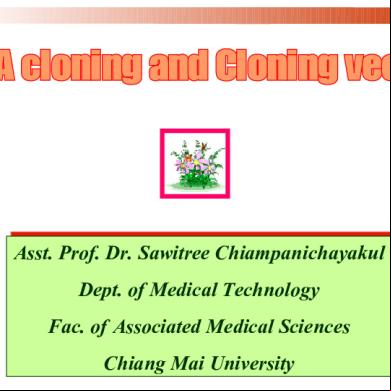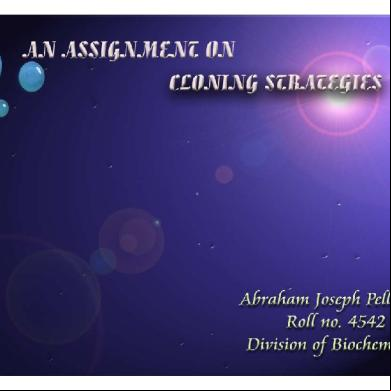Cloning Vectors For Eukaryotes 3285f
This document was ed by and they confirmed that they have the permission to share it. If you are author or own the copyright of this book, please report to us by using this report form. Report 3b7i
Overview 3e4r5l
& View Cloning Vectors For Eukaryotes as PDF for free.
More details w3441
- Words: 469
- Pages: 14
Cloning Vectors for Eukaryotes
1 of 14
http://bioweb.wku.edu/courses/biol350/cloningvecteuk9/review.html
Introduction to Recombinant Genetics- Biology 350 Index • Syllabus • CourseInfo • References • Assignment • Next
CLONING VECTORS FOR EUKARYOTES Vectors For Yeast The 2 µm plasmid is a naturally occuring 6 kb episomal plasmid found in yeast.
Selection is based on nutrition instead of drugs. Yeast cells that are auxotrophic (unable to synthesize an essential component, like an amino acid) can only grow when nutritionally supplemented, or when the missing nutritional function is provided for by genes contained on a plasmid or extra chromosome.
6/16/2011 4:17 AM
Cloning Vectors for Eukaryotes
2 of 14
http://bioweb.wku.edu/courses/biol350/cloningvecteuk9/review.html
Many eukaryotic vectors contain both eukaryotic and prokaryotic signals and can be replicated in both types of cells. These are called shuttle vectors.
Often, much of the cloning is done in prokaryotic systems and then the recombinant vectors are grown in eukaryotic cells.
6/16/2011 4:17 AM
Cloning Vectors for Eukaryotes
3 of 14
http://bioweb.wku.edu/courses/biol350/cloningvecteuk9/review.html
Why not just express all genes in prokaryotes? Why transfer to eukaryotes for expression? YEp Yeast episomal plasmid
6/16/2011 4:17 AM
Cloning Vectors for Eukaryotes
4 of 14
http://bioweb.wku.edu/courses/biol350/cloningvecteuk9/review.html
YIp - Yeast integrative plasmid YRps - Yeast replicative plasmid
6/16/2011 4:17 AM
Cloning Vectors for Eukaryotes
5 of 14
http://bioweb.wku.edu/courses/biol350/cloningvecteuk9/review.html
YACs - Yeast artificial chromosome (600-1400 kb capacity)
6/16/2011 4:17 AM
Cloning Vectors for Eukaryotes
6 of 14
http://bioweb.wku.edu/courses/biol350/cloningvecteuk9/review.html
CLONING VECTORS FOR HIGHER PLANTS Agrobacterium Tumefaciens The system was derived from the bacteria that causes crown gall disease in plants.
6/16/2011 4:17 AM
Cloning Vectors for Eukaryotes
7 of 14
http://bioweb.wku.edu/courses/biol350/cloningvecteuk9/review.html
During infection, the Ti plasmid is integrated into the plant chromosomal DNA.
6/16/2011 4:17 AM
Cloning Vectors for Eukaryotes
8 of 14
http://bioweb.wku.edu/courses/biol350/cloningvecteuk9/review.html
The functions of the Ti plasmid have been divided between two plasmid-like vectors which are co transformed and operate as a binary vector system.
6/16/2011 4:17 AM
Cloning Vectors for Eukaryotes
9 of 14
http://bioweb.wku.edu/courses/biol350/cloningvecteuk9/review.html
Transformed plants can be recovered.
6/16/2011 4:17 AM
Cloning Vectors for Eukaryotes
10 of 14
http://bioweb.wku.edu/courses/biol350/cloningvecteuk9/review.html
A binary vector
6/16/2011 4:17 AM
Cloning Vectors for Eukaryotes
11 of 14
http://bioweb.wku.edu/courses/biol350/cloningvecteuk9/review.html
Direct gene transfer randomly integrates supercoiled DNA into cells (no homology required).
CLONING VECTORS FOR ANIMALS
6/16/2011 4:17 AM
Cloning Vectors for Eukaryotes
12 of 14
http://bioweb.wku.edu/courses/biol350/cloningvecteuk9/review.html
Cloning Into Insect Cells Drosophilia cells and the P vector
Baculovirus
6/16/2011 4:17 AM
Cloning Vectors for Eukaryotes
13 of 14
http://bioweb.wku.edu/courses/biol350/cloningvecteuk9/review.html
Cloning In Mammals Purposes for cloning into animals Gene knockout Production of recombinant proteins Gene therapy Vectors are often derived from viral components
6/16/2011 4:17 AM
Cloning Vectors for Eukaryotes
14 of 14
© 2005 by CA Rinehart
http://bioweb.wku.edu/courses/biol350/cloningvecteuk9/review.html
Index • Syllabus • CourseInfo • References • Assignment • Next
This material is intended for use only by WKU students ed for Biology 350. Other uses prohibited.
6/16/2011 4:17 AM
1 of 14
http://bioweb.wku.edu/courses/biol350/cloningvecteuk9/review.html
Introduction to Recombinant Genetics- Biology 350 Index • Syllabus • CourseInfo • References • Assignment • Next
CLONING VECTORS FOR EUKARYOTES Vectors For Yeast The 2 µm plasmid is a naturally occuring 6 kb episomal plasmid found in yeast.
Selection is based on nutrition instead of drugs. Yeast cells that are auxotrophic (unable to synthesize an essential component, like an amino acid) can only grow when nutritionally supplemented, or when the missing nutritional function is provided for by genes contained on a plasmid or extra chromosome.
6/16/2011 4:17 AM
Cloning Vectors for Eukaryotes
2 of 14
http://bioweb.wku.edu/courses/biol350/cloningvecteuk9/review.html
Many eukaryotic vectors contain both eukaryotic and prokaryotic signals and can be replicated in both types of cells. These are called shuttle vectors.
Often, much of the cloning is done in prokaryotic systems and then the recombinant vectors are grown in eukaryotic cells.
6/16/2011 4:17 AM
Cloning Vectors for Eukaryotes
3 of 14
http://bioweb.wku.edu/courses/biol350/cloningvecteuk9/review.html
Why not just express all genes in prokaryotes? Why transfer to eukaryotes for expression? YEp Yeast episomal plasmid
6/16/2011 4:17 AM
Cloning Vectors for Eukaryotes
4 of 14
http://bioweb.wku.edu/courses/biol350/cloningvecteuk9/review.html
YIp - Yeast integrative plasmid YRps - Yeast replicative plasmid
6/16/2011 4:17 AM
Cloning Vectors for Eukaryotes
5 of 14
http://bioweb.wku.edu/courses/biol350/cloningvecteuk9/review.html
YACs - Yeast artificial chromosome (600-1400 kb capacity)
6/16/2011 4:17 AM
Cloning Vectors for Eukaryotes
6 of 14
http://bioweb.wku.edu/courses/biol350/cloningvecteuk9/review.html
CLONING VECTORS FOR HIGHER PLANTS Agrobacterium Tumefaciens The system was derived from the bacteria that causes crown gall disease in plants.
6/16/2011 4:17 AM
Cloning Vectors for Eukaryotes
7 of 14
http://bioweb.wku.edu/courses/biol350/cloningvecteuk9/review.html
During infection, the Ti plasmid is integrated into the plant chromosomal DNA.
6/16/2011 4:17 AM
Cloning Vectors for Eukaryotes
8 of 14
http://bioweb.wku.edu/courses/biol350/cloningvecteuk9/review.html
The functions of the Ti plasmid have been divided between two plasmid-like vectors which are co transformed and operate as a binary vector system.
6/16/2011 4:17 AM
Cloning Vectors for Eukaryotes
9 of 14
http://bioweb.wku.edu/courses/biol350/cloningvecteuk9/review.html
Transformed plants can be recovered.
6/16/2011 4:17 AM
Cloning Vectors for Eukaryotes
10 of 14
http://bioweb.wku.edu/courses/biol350/cloningvecteuk9/review.html
A binary vector
6/16/2011 4:17 AM
Cloning Vectors for Eukaryotes
11 of 14
http://bioweb.wku.edu/courses/biol350/cloningvecteuk9/review.html
Direct gene transfer randomly integrates supercoiled DNA into cells (no homology required).
CLONING VECTORS FOR ANIMALS
6/16/2011 4:17 AM
Cloning Vectors for Eukaryotes
12 of 14
http://bioweb.wku.edu/courses/biol350/cloningvecteuk9/review.html
Cloning Into Insect Cells Drosophilia cells and the P vector
Baculovirus
6/16/2011 4:17 AM
Cloning Vectors for Eukaryotes
13 of 14
http://bioweb.wku.edu/courses/biol350/cloningvecteuk9/review.html
Cloning In Mammals Purposes for cloning into animals Gene knockout Production of recombinant proteins Gene therapy Vectors are often derived from viral components
6/16/2011 4:17 AM
Cloning Vectors for Eukaryotes
14 of 14
© 2005 by CA Rinehart
http://bioweb.wku.edu/courses/biol350/cloningvecteuk9/review.html
Index • Syllabus • CourseInfo • References • Assignment • Next
This material is intended for use only by WKU students ed for Biology 350. Other uses prohibited.
6/16/2011 4:17 AM





